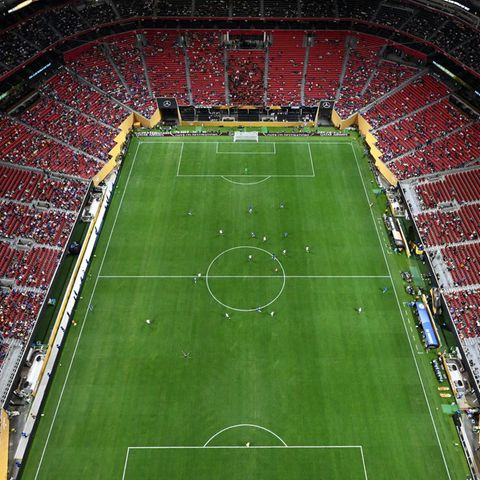The federal government often emphasizes how important press freedom is to it. Banning a media company is therefore a step that must be carefully considered and well-founded.
With the right-wing extremist “Compact” magazine, Federal Minister of the Interior Nancy Faeser (SPD) has banned a company that insults ministers as “criminals” and describes itself as the “voice of resistance”. The most important questions and answers about the ban:
What is “Compact” known for?
The tabloid-style “Compact” magazine has been published monthly since 2010. Its editor-in-chief Jürgen Elsässer also appears at events. Through videos and online offerings, the media company now reaches a larger audience beyond the circle of magazine readers. For example, the magazine speaks of an “asylum bomb”. A recent cover photo claimed that “German generals are planning an attack on Russia”. Recently, “Compact” showed the Thuringian AfD state chairman Björn Höcke next to former US President Donald Trump with the headline “2024 The Turning Point”. Leading politicians are repeatedly insulted as “criminals” in the magazine – with the exception of representatives of the AfD.
What does Faeser base the ban on?
Her ministry has come to the conclusion that people can be incited by publications and events by “Compact” and “incited to act against the constitutional order”. In doing so, it refers to “anti-Semitic, racist, anti-minority, historical revisionist and conspiracy-theoretical content”. According to the Office for the Protection of the Constitution, the media company agitates not only against the federal government, but also “generally against the political system”.
According to the Interior Ministry, “Compact” uses “resistance and revolutionary rhetoric” and uses “distorted and manipulative representations”.
Legally, the step amounts to a ban on associations – according to the Interior Ministry, companies can also be banned under certain conditions.
What exactly is forbidden now?
The sale of the magazine, the website and symbols associated with the magazine. This also includes the “Blue Wave”. Editor-in-chief Elsässer chose this relatively new symbol for a campaign with which he wanted to promote a change of government after the next federal election in September 2025. Blue is the color of the AfD, whose representatives, however, had expressed some reservations about the campaign, probably because they feared a possible new party donations scandal.
How much influence does “Compact” have?
According to its own information, the magazine has a circulation of around 40,000 copies, although this has not been independently verified. Compact TV has 345,000 subscribers on YouTube. According to the Federal Ministry of the Interior, “Compact” is a “central player in the networking of the ‘New Right'”. The “New Right” describes a scene that represents ideas of an ethnically homogeneous state with authoritarian features and at the same time distances itself from right-wing groups that refer to National Socialism.
The media company has close ties to the right-wing extremist Identitarian Movement and the far-right AfD, among others. According to the Federal Office for the Protection of the Constitution, the regional party “Free Saxony” is also part of the inner circle.
Who is Jürgen Elsaesser?
The 67-year-old has a turbulent political history behind him. As an author and activist, the former teacher was once located on the far left of the spectrum. After 2005, Elsässer moved ever further towards the far right. While other journalists are occasionally attacked on the open stage at AfD party conferences, the “Compact” editor-in-chief moves there like a fish in water.
“Of course the AfD is an important factor,” he said recently at an open-air event in Sonneberg, Thuringia. At the same time, he expressed some sympathy for the Sahra Wagenknecht (BSW) alliance and for Russian President Vladimir Putin, whom he describes as a “statesman who stands up for his people, his country and his state.”
Does the ban have any impact on the AfD?
Not directly, but above all the far-right wing of the party is losing a platform for spreading its content. The AfD member of the Bundestag, Jürgen Braun, who is not considered to be part of this movement, writes on X: “Compact-Elsässer has been rude to me in a primitive way.” Nevertheless, he supports “Compact” against what he calls the “unconstitutional ban.”
The federal executive director of the Left Party, Katina Schubert, believes that it is now “unavoidable” to examine a ban on the AfD. She believes: “The ban on the right-wing hate sheet must not remain just a symbolic bombshell.” The AfD is currently being monitored by the Federal Office for the Protection of the Constitution as a suspected right-wing extremist case. It is not yet clear whether the domestic secret service could classify the entire party as a confirmed right-wing extremist effort in the future.
The Bundestag, Bundesrat and Federal Government are the only constitutional bodies authorized to submit an application to ban a party. The decision on such an application is made by the Federal Constitutional Court. One prerequisite is that it can be proven that the party in question has an aggressive and combative attitude.
How unusual is a media ban?
This is relatively rare – in such cases, freedom of the press must be weighed against the arguments in favor of a ban. During his time as Federal Minister of the Interior, Thomas de Maizière (CDU) banned the right-wing extremist internet platform “Altermedia Deutschland” in 2016. Former Federal Minister of the Interior Horst Seehofer (CSU) closed down Mezopotamien Verlag und Vertrieb GmbH and MIR Multimedia GmbH as sub-organizations of the Kurdish Workers’ Party PKK in 2019.
Source: Stern
I have been working in the news industry for over 6 years, first as a reporter and now as an editor. I have covered politics extensively, and my work has appeared in major newspapers and online news outlets around the world. In addition to my writing, I also contribute regularly to 24 Hours World.




